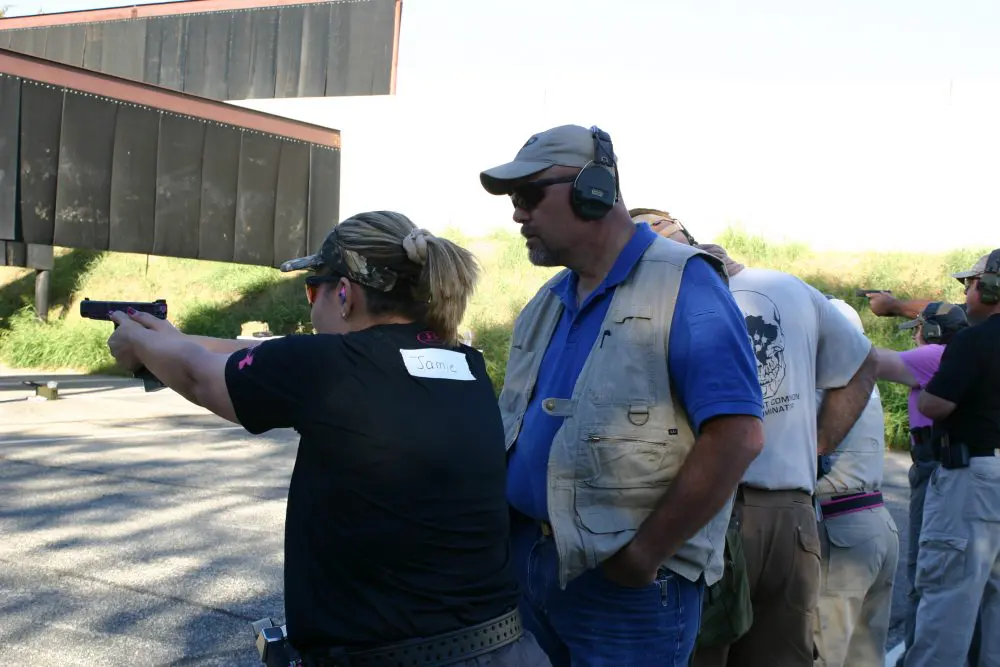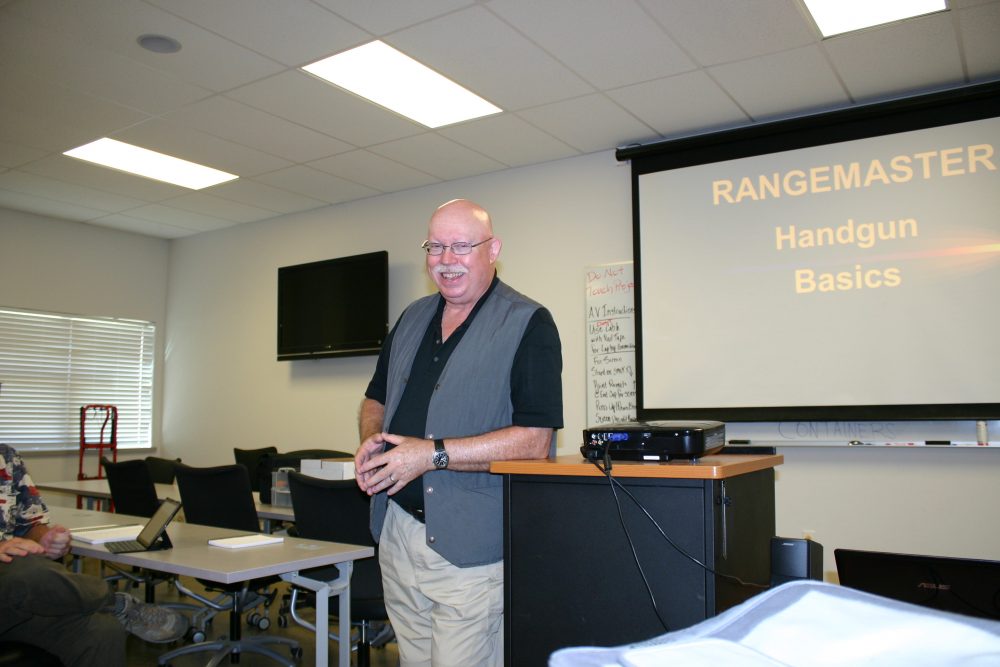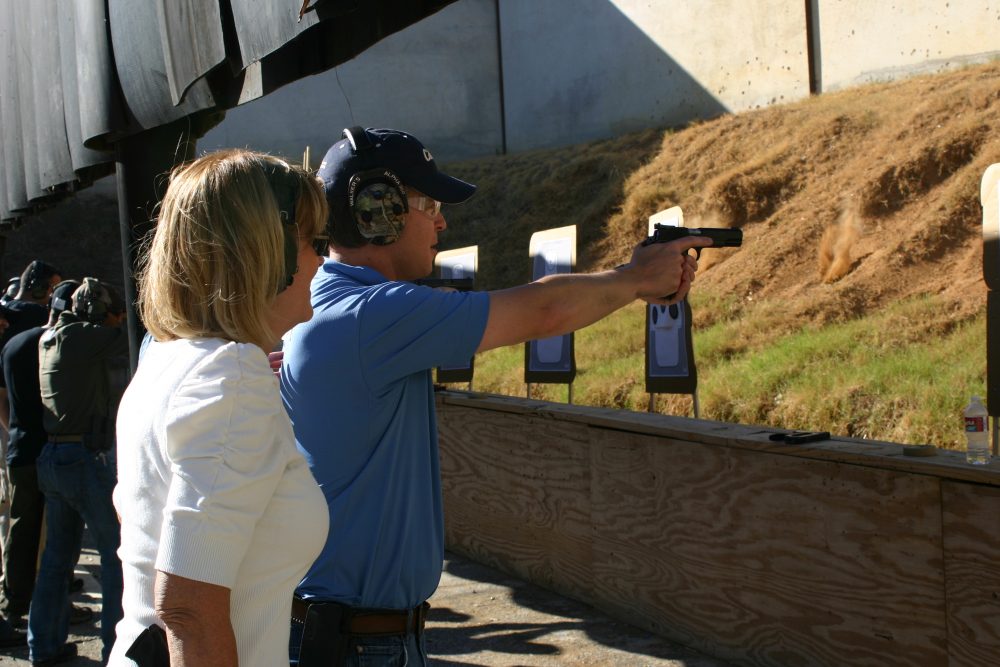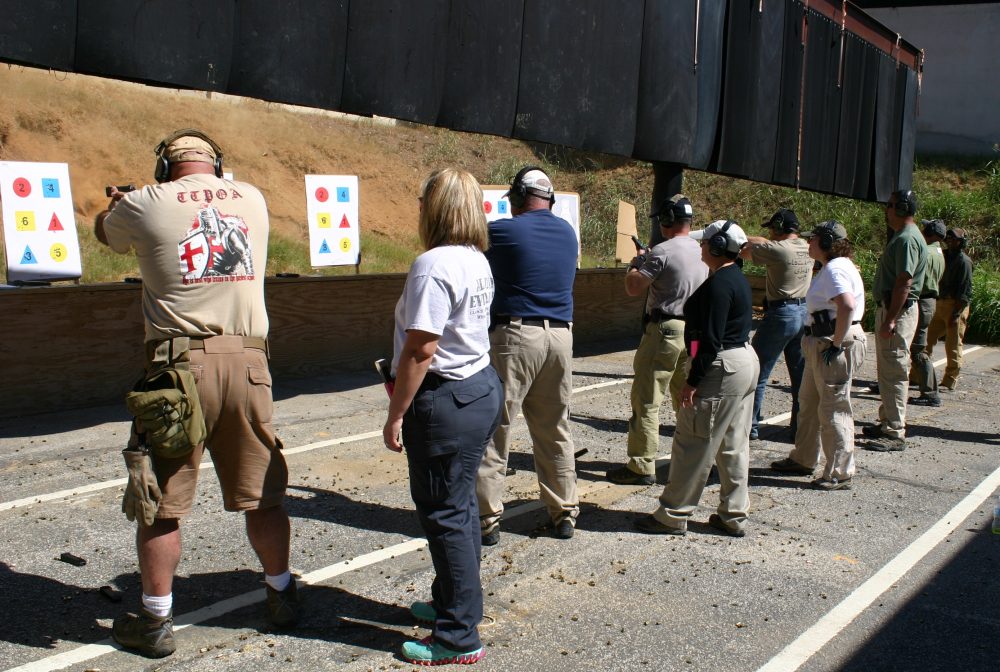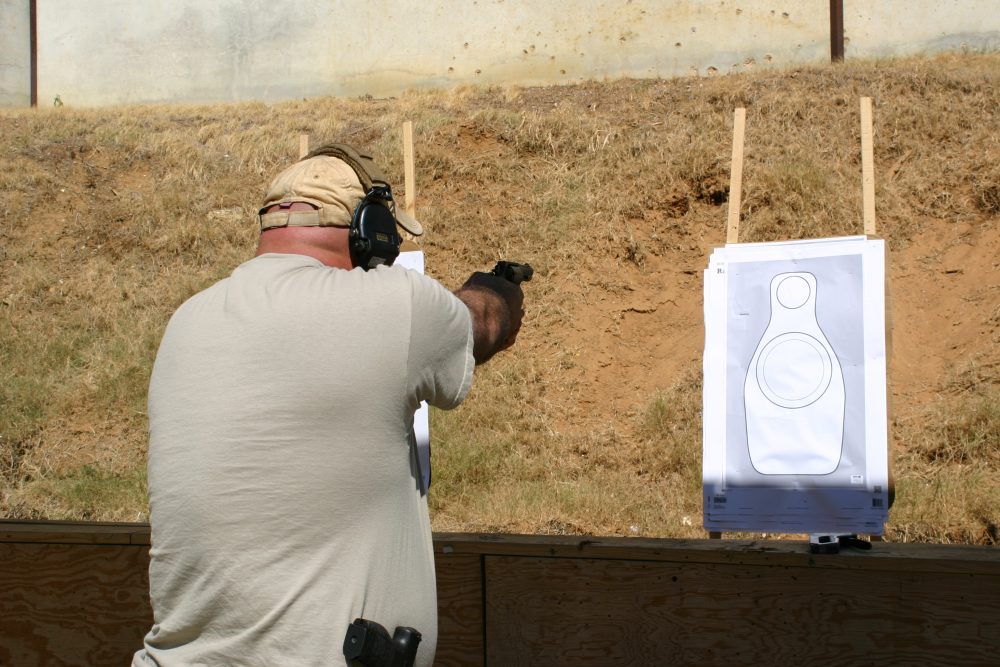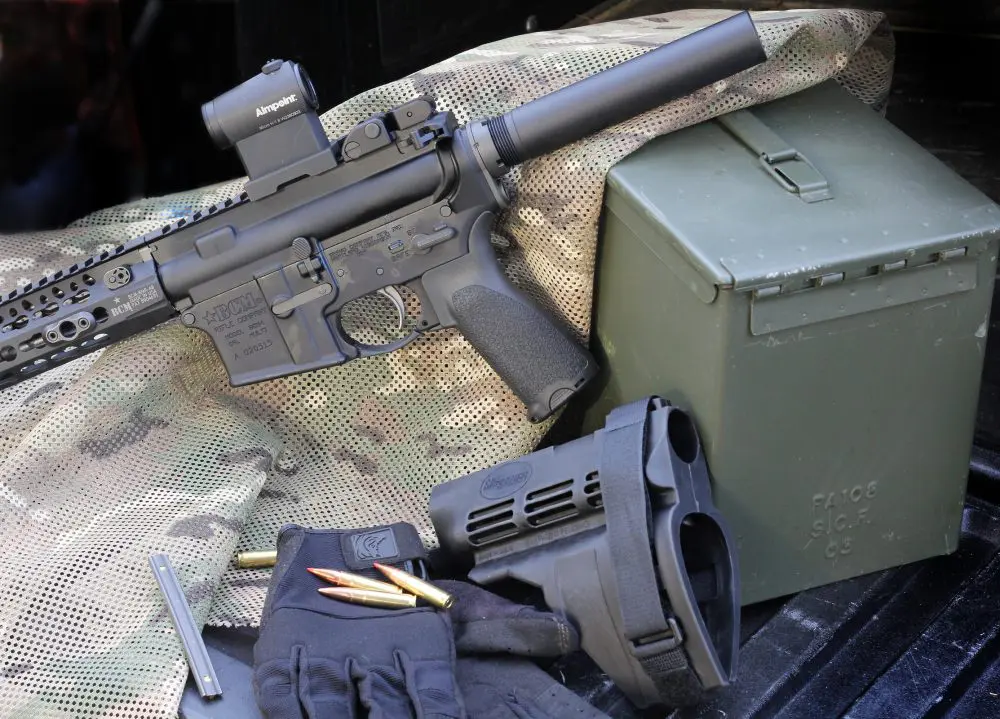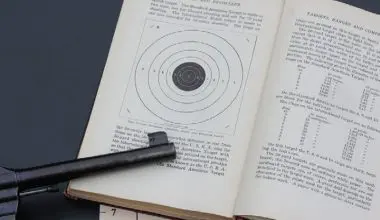Tom Givens lecturing.
When it comes to defensive firearm training geared specifically toward private citizens, I feel confident in stating that Tom Givens is one of the best instructors in the U.S. I can say this because I have been in his class, and because he has had over 60 of his non-LEO students prevail in shooting encounters with criminals.
That last figure is kind of amazing, but keep in mind that Tom spent nearly two decades running the largest indoor range in Memphis, Tennessee, a city with a very high crime rate. Something like 5 to 10% of the nation’s justifiable homicides take place in Memphis—a city where around 50,000 people, or nearly 7% of the population have concealed-carry permits.
There, Tom and his staff taught thousands of students everything from the state-mandated concealed-carry class to a variety of more advanced firearms classes.
Tom himself spent 25 years in law enforcement. For many of those years he was a detective. He investigated violent crimes and interviewed victims, including shooting victims. Tom drew heavily from this experience to develop a program of instruction geared toward defensive firearm carry and use by armed citizens. He further refined it based on debriefing dozens of his own students who prevailed in gunfights.
After 18 years running a successful range and training facility, Tom has decided to take his company, Rangemaster Firearms Training Services, completely on the road. Instructing is not something new to Tom. He’s been doing it for over 35 years and has been offering instructor classes since 1997.
Givens is passionate about developing grassroots-level trainers to provide instruction to those who need it the most—new shooters and people who have not had any training. Tom feels it is essential to bring new shooters aboard and provide them with competent training.
Lynn Givens coaches student.
Table of Contents
INSTRUCTOR DEVELOPMENT PROGRAM
Tom designed this program to develop instructors who could teach people with little to no experience and bring them up to a level of competency where they can carry a firearm and use it if necessary.
I recently attended this class. It was sponsored by Wayne Dobbs and Darryl Bolke of Hardwired Tactical Shooting. Though highly experienced instructors themselves, they participated in the class as ordinary students. Once completed, students were certified to teach this basic material without paying any franchise fees or tithing to Givens or anyone else.
The class was held at the Dallas Pistol Club’s private outdoor range and consisted of 12 men and three women, most of whom were actively teaching some facet of firearms—from state-mandated concealed-carry classes to more advanced pursuits. Included among these were two active-duty military, two active-duty peace officers, and two retired peace officers.
After the introductions, each student received a 200-page course manual, which they would be responsible to learn for a written test on the final day. The comprehensive manual covered much of the course material, including everything from firearm, holster and ammo selection to defensive shooting techniques, coaching and principles of adult learning, mindset, legalities, and setting up lesson plans. All of this and much more would be covered in the three-day class.
For the second day of class, students had to present a short block of instruction on an assigned subject that included some type of visual aid. This was a challenge given the long days and the fact that most of the students came from out of town to attend this class and thus did not have a houseful of things to draw on.
The course was co-taught by Tom’s wife, Lynn, herself an excellent instructor and a formidable shot. Women trainers come into their own when it comes to helping women integrate concealment holsters and clothing.
Students qualify at 25-yard line.
LECTURE MATERIAL
While the class was geared toward training people how to teach, all the information covered was highly relevant to anyone interested in the defensive use of firearms. Recognizing subtle signs of criminals and the early stages of victim selection were integral to the curriculum. It would take several articles to cover all the valuable information that Tom expounded upon. While Tom’s admonition to avoid getting involved in other people’s potentially volatile situations seems obvious, judging by news reports, it is something far too many people ignore.
Over the course of the three days, we alternated between classroom and range time. The first few hours were spent in lecture and discussion. Tom sees gun safety not as range rules but as lifestyle rules that enable you to live safely without presenting an unjustified threat to anyone. Tom also covered selecting suitable handguns for self-defense and provided a comprehensive breakdown of the physical mechanics of shooting a handgun.
Givens always had a solid rationale and explanation for everything he taught. He stressed that this is essential for an instructor. Students—especially new students—have lots of questions that require concrete answers to give them confidence to accept the validity of the material as well as that of the instructor.
During this course, students alternated between shooting and acting as coaches. Students rotated every hour to work with different people.
When instructing students new to firearms, Tom suggested finding non-firearm analogies to get a point across. One example he used is that a handgun that holds more rounds in the magazine can be likened to a car that has more gas in the tank—it can take you farther without having to stop to refuel if you need to do so in an emergency.
Tom exhibited an amazing command of firearms and training history and could easily pinpoint where a specific technique came from and what the rationale for using it was at the time.
Because this class was geared toward private citizen defensive use of firearms, Tom spent some time discussing the legalities of deadly force and how to teach them. Tom provided a one-sentence legal lecture that summarizes the basics: “I will forget that I have a gun unless it is to terminate an immediate deadly threat to me or to someone for whom I am responsible.”
Givens also spent a good amount of time discussing mindset. He showed videos of people who were victims of violent crime as well as a police officer at a vehicle stop who kept issuing verbal commands while the suspect removed a rifle and ultimately killed the officer.
He contrasted this with films and interviews with Lance Thomas, the California watch-store owner who got into four different gunfights with criminals who came to rob his store and kill him. Thomas prevailed in all those gunfights, killing several armed attackers.
Student coach observes other student’s technique.
RANGE TIME
When it came time to shoot, we broke into two-person teams. One person would shoot while the other assumed the role of coach. For each drill, the shooter changed places with the partner and became the coach. Every hour or so, students rotated to work with different people. As the class progressed, Tom and Lynn gave the coaches an increasing number of specifics to watch for.
Range work began with the fundamentals of shooting individual shots and then progressed to multiple rapid shots. Multiple shots increased the importance of a firm and proper grip. A weak grip increases the gun’s recoil and movement in the hands and requires more realignment between shots. This consumes time.
The only things you have to do between shots are reset the trigger and realign the sights. Coaches watched to see if shooters’ fingers came off the trigger or if they were readjusting their grips between shots. Finally we added the drawstroke from the holster.
Building a solid base and learning how to teach it were important parts of the class. Experience and skill levels varied among students. Givens stressed that what you do repetitively on the range will come out when you defend yourself.
The fundamentals Tom placed the most emphasis on were sight alignment and trigger control. A bad trigger pull or jerking the trigger has far more potential to cause a miss than bad sight alignment.
Tom is a proponent of using the sights unless the gun has to be fired from retention. At a distance of two to 12 yards, the flash sight picture typically puts the rounds in the vitals or close to them. The farther the target, the more the sight picture needs to be refined. Instructor candidates had to be competent out to 25 yards and pass both Tom’s course of fire along with that of the FBI. Our class, which admittedly had a few ringers, shot record high scores.
We practiced drills at seven yards where the front sight post was not centered in the rear sight but deliberately off to one side or the other, or too high or too low. The hits were acceptable as long as the trigger pull was good.
Three to five yards is where the bulk of Tom’s students’ shootings have taken place. At this distance, perfect sight alignment isn’t a big deal, but jerking the trigger can cause a miss or a bad hit. Trigger manipulation is the major contributing factor to accurate hits. You can do almost everything else wrong and get the trigger right and achieve decent hits at typical civilian defensive distances.
Students worked with revolvers, since they may be encountered in a class.
Tom explained that he dislikes using the word “squeeze” relating to the trigger because squeeze usually means clenching your entire hand, which of course will unsteady the handgun and throw your shot off. Rather, you should concentrate on pressing the trigger straight to the rear and not squeezing your hand. Semantics are important.
One tactic Tom covered was sidestepping while drawing the gun. He advocates this for inside of 15 to 16 feet when there is room to do so and the situation permits it. This movement serves to briefly distract the criminal, since they are surprised by your sidestep while you are drawing.
The final morning included a session on revolvers and how to instruct students with them. While Tom is not a fan of revolvers as primary defensive sidearms in this day and age, he feels that instructors need to be able to teach students who choose them as defensive handguns.
Tom stressed how important it is for teachers to continue their own training under different instructors in order to increase their skills and prevent themselves from stagnating.
Tom and Rangemaster offer a wide variety of classes geared toward people of all experience levels. The overriding emphasis of his classes is civilian defense against criminals.
Even if you have no intention of teaching, the skills and knowledge you will gain about defensive firearms use from Tom’s instructor class is worth much more than the price of admission.
SOURCES
RANGEMASTER FIREARMS TRAINING SERVICES
www.rangemaster.com
HARDWIRED TACTICAL SHOOTING
www.hardwiredtacticalshooting.com
DALLAS PISTOL CLUB
www.dallaspistolclub.com
